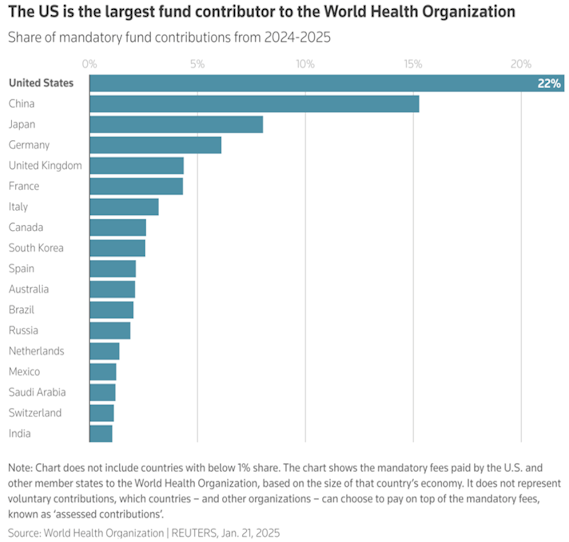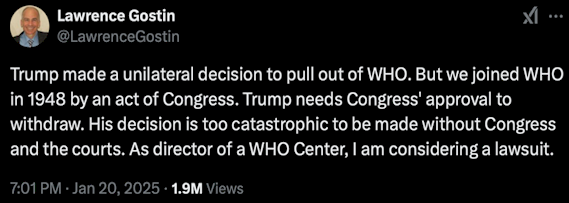|
|
|
|
|
Epi
Brief: January 2025 |
|
Author:
Madeline Roberts, PhD, MPH 1. 1. The recent “Ten Americas” study shows dramatic differences in US life expectancies. Study authors defined ten Americas based on race, ethnicity, location, metropolitan status, income, and Black–White residential segregation: America 1—Asian individuals America 2—Latino individuals in other counties America 3—White (majority), Asian, and American Indian or Alaska Native (AIAN) individuals in other counties America 4—White individuals in non-metropolitan and low-income Northlands America 5—Latino individuals in the Southwest America 6—Black individuals in other counties America 7—Black individuals in highly segregated metropolitan areas America 8—White individuals in low-income Appalachia and Lower Mississippi Valley America 9—Black individuals in the non-metropolitan and low-income South America 10—AIAN individuals in the West Why it matters: Life expectancy for Native Americans living in the western US is under 64 years; this group comprises 0.40% of the US population. By contrast, Asian individuals in the US have a life expectancy of approximately 84 years. The gap between these two Americas with the lowest and highest life expectancies widened from 13.9 years in 2010 to 20.4 years in 2021. Substantive differences in life expectancy predate the pandemic but increased during the initial stages of COVID-19. Among children under 5, Black children had the lowest partial life expectancy. The study authors also identified substantial differences in income and education among the ten Americas. This study provides bleak, quantifiable evidence of the colossal differences in subsets of the US population and demonstrates the severity of the need for targeted health interventions. 2. The National Academy of Medicine (NAM) released Vital Directions for Health and Health Care: Priorities for 2025 this month, which comprises six articles. Published every four years as an evidence-based guide for the incoming presidential administration, the 2025 guide has six emphases: ♦ transforming health care payment and delivery ♦ integrating AI into healthcare ♦ modernizing public health ♦ addressing the health impacts of climate change ♦ improving women’s health ♦ advancing the biomedical research enterprise
The NAM guide
advocates for standardized data sharing to strengthen the US public
health system and AI training and community partnerships to bolster
the public health workforce. Action items for AI in health include
creating clear definitions and standards and monitoring and retraining
models to eliminate bias. It also calls for the “creation of an
independent, multidisciplinary advisory body to develop a strategic
plan aligning research efforts with national health priorities and
coordinating efforts across sectors.” 3. Health and Human Services released its AI Strategic Plan this month, outlining the Departments' AI implementation objectives. The Plan primarily encompasses medical research, medical product development and safety, healthcare delivery, human services delivery, and public health. The Plan emphasizes four goals:
One of AI’s epidemiologic superpowers is risk prediction, such as disease outbreaks, where early detection can improve response by increasing lead time for mobilization and deployment of countermeasures. Resource allocation optimization is another where AI can identify high-need, high-risk areas for timely interventions. AI can also alleviate some of the burden on public health staff by automating administrative tasks and preliminary literature reviews with oversight from an analyst. However, AI can perform poorly and cause harm in areas like insurance coverage determination and prior authorization. It has also perpetuated racial bias in insurance models. To this end, one of the near-term goals of the Plan is to “increase the oversight and enforcement of existing federal laws and regulations, such as those prohibiting denying medically necessary, covered services or discrimination in access to federal benefits.” Read the Plan here. 4. The US is slated to exit the World Health Organization (WHO) in one year. On his first day in office, President Trump signed an order to leave the WHO and end financial support for the organization. The order cites mismanagement of COVID-19 and disproportionate, “unfairly onerous payments” for the US compared to other nations, namely China. Why it matters: as the largest financial supporter of the WHO, US withdrawal impacts everything from international disease surveillance to key WHO programs. It also means the US would lose access to the WHO global database for emerging and existing disease threats.
WHO issued a statement expressing both regret at the decision and hope for reconsideration. Lawrence Gostin, Georgetown Law professor of global health law and Director of the WHO Collaborating Center on Public Health Law & Human Rights, communicated the potential for legal action on X:
More on the US exit from WHO here. 5. RETRACTED: Hydroxychloroquine for COVID-19. Nearly 5 years after its publication, The International Journal of Antimicrobial Agents formally withdrew the paper that suggested the antimalarial drug to treat COVID-19. The paper had methodological errors and ethical breaches. Why it matters: cardiac arrest, heart rhythm abnormalities, and liver and kidney problems were reported with hydroxychloroquine treatment for COVID-19. From February to March 2020, the number of hydroxychloroquine prescriptions spiked from 1,143 to 75,569—an 80-fold increase—causing anxiety-inducing medication shortages for some lupus patients. By June 2020, the FDA revoked the Emergency Use Authorization (EUA) for hydroxychloroquine to treat COVID-19. The French Medicines Agency (ANSM) filed criminal charges against Hospital Institute of Marseille Mediterranean Infection (IHU), the research hospital where the study was conducted. The hospital is under criminal investigation for conducting research without approval from an external evaluation committee and alleged falsification of ethics committee documents. Further reading here. ■ |
|
|



